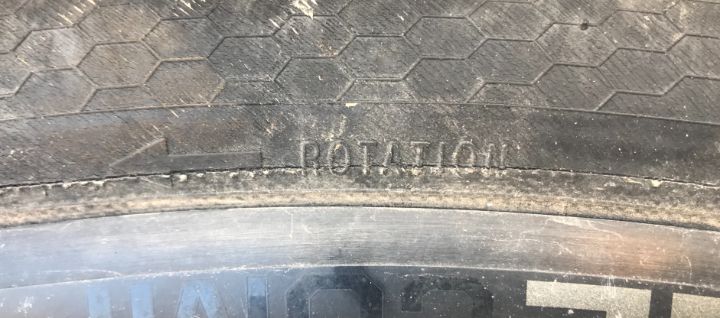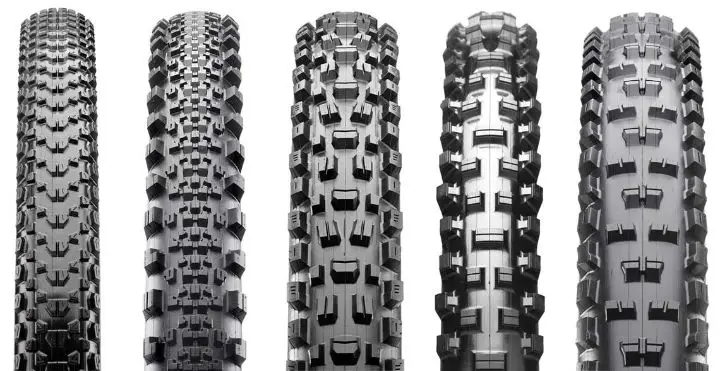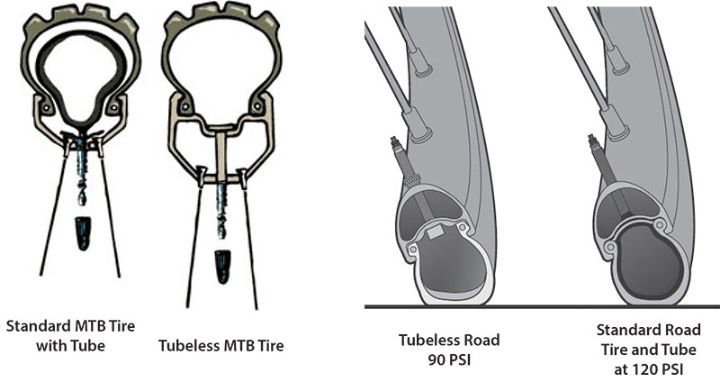For those of you who need the answer to this question quickly, here it is. Yes, most bicycle tires have a specific direction. You’ll have probably already known about this fact if you’re interested in cars. Having your tires fitted the correct direction is much less important on a bike than it is on a car but there are still advantages you can benefit from when having them fitted correctly.
Which way do I Orientate my Bike Tires?

Very simply, the tire will have markings showing the orientation. When you install your tires they need to roll in the same direction the arrow is pointing.
Some tires are marked with more than one arrow, especially MTB tires. The two arrows dictate the rolling direction when the tire is used on the front or rear wheel. The different wheels perform different tasks. Front wheels do most of the braking and steering while rear wheels do most of the propulsion. These two tasks transmit forces in different directions. This is why some tires recommend being fitted in opposite directions.
Why Does It Matter About Tire Orientation?

For BMX and road bikes it doesn’t matter that much. On the other hand, mountain bike tracks are extremely unpredictable, wet and muddy. Now, a bicycle won’t aquaplane, the contact area is too small. A bike would need to be travelling at over 100 mph before there’d be any risk of aquaplaning.
If you’re riding on dry, flat concrete the best tread pattern is actually nothing, just like F1 cars. This is because the rubber deforms around the concrete and so a far larger surface area will be in contact with the floor. There are still advantages of having traded tires on a bike though. The tread pattern acts as a kind of cog, interlocking with the loose terrain of a mountain bike track. This cog-like behaviour enables propulsion, cornering and braking transfer effectively into enough surface area of the track.
History of Bike Tires
Tires and the way they are implemented are relatively new concerning other developments of bicycle parts. Original tires, if they can be called that, were iron bands fitted around the wooden wheels that were originally used.
Following this, the penny-farthing opted for solid rubber tires. These provided little more suspension or comfort but at least they were on the right track. Clement Ader secured the first patent for rubber wheels in 1868 intending to make bicycle riding more comfortable.
John Boyd Dunlop realised the advantages of using pneumatic rubber tires in 1887 when creating the first pneumatic tire for his son’s bike. Two years later the Dunlop Pneumatic Tyre Company was founded, attracting the adoration of bike racers due to the added speed and comfort of pumped up tires.
Attaching Tires to your Rim
Most bike tires use the clincher method of attaching to the rim. This requires a steel wire to be developed within the edge of the tire that interlocks with the flange on the walls of the rim. When an innertube then presses on the inside of the tire the flange secures itself even tighter. Tubeless tires require the use of the clincher method as an airtight seal is needed to keep the air inside the tire.
Another way of securing a tire to its rim is the tubular or sew-up method. It’s much less common to use this method. Some tires are torus-shaped and attach to their respective tubular rims with adhesive. In this situation, the rim will provide a shallow circular outer cross-section, where the tire lies instead of the flanges on clincher tires.
Tubed and Tubeless Tires

You’ve probably heard of tubeless tires before. Car tires are all tubeless, with the air being pumped directly into the airtight tire itself. The same is being done more often with bikes. We’ve detailed this before in our post on the best PSI for a BMX tire[].
Tubed tires are still by far the norm with the vast majority of riders using them. Tubeless riders are growing though, especially in the road biking and mountain biking disciplines. MTB is suited to tubeless riding as they are often ridden with lower air pressures. Tubeless removes the risk of snakebite punctures, which are an epidemic in mountain biking and BMX.
Tubeless tires work in the same way as clinchers, described above. The air pushes the bead of the tire into the flange of the rim, creating a high-quality, airtight seal. Liquid sealant can then be injected into fill any areas that might lack structural stability. The sealant will also plug small punctures that happen during normal riding.
If you’re thinking of riding tubeless you need to make sure your rim and tire are compatible with this riding style. Not all rims will create a good enough seal with the tire for it to be inflated without an innertube.
Tire Materials
Synthetic rubber is used for the tread on a bike tire. Carbon black and silica are then added at varying amounts depending on the aim of the tire. Expensive tires destined to be well ridden on rough surfaces can afford more silica and other additives while a softer road tire might require oils and lubricants to soften it up.
The sidewalls and cross-section of the tire can also be made from different materials. The sides of a tire don’t attract as much wear and so can be softer but grippier while keeping the main area tougher.
We’ve discussed the tread pattern a lot in this post. Patterns come in an unlimited amount of designs. Some are purely for aesthetic appeal while others really do help certain types of riding.
Smooth tires are perfect for road bikes and some types of BMX. Slick tires sometimes have a minor amount of tread to deal with water when necessary. As well as the omnidirectional and unidirectional tread patterns that are used on a lot of mountain bikes there are now specific tread patterns with small dimples that help reduce air drag, perfect for racing or high-speed disciplines.
Tire Inflation
Different cycling disciplines benefit from different tire pressures depending on the terrain they are suited for. Tire pressures range from a low of 4.5PSI for fat bikes that have huge tires up to race bikes with tiny tires and a PSI as high as 220. Along with the direction of rotation, the maximum tire pressure is usually printed on the sidewall of the tire.
The higher the pressure the more efficient and agile the ride will be, while also reducing the likelihood of a snake bite puncture. Softer tires will be more comfortable and offer more grip in certain circumstances but agile manoeuvring and pinch flats become more of a problem.
Innertubes are never completely impermeable and will always slowly lose pressure. Different materials are better at retaining pressure than others but the fact remains the same. The type of gas used to inflate innertubes also affects the speed at which they lose air. Oxygen is obviously the most common gas to use with carbon dioxide being used in canisters for roadside repairs. Some high-level competitors also use helium as the atom is very light but this just proves even more detrimental to pressure loss.


